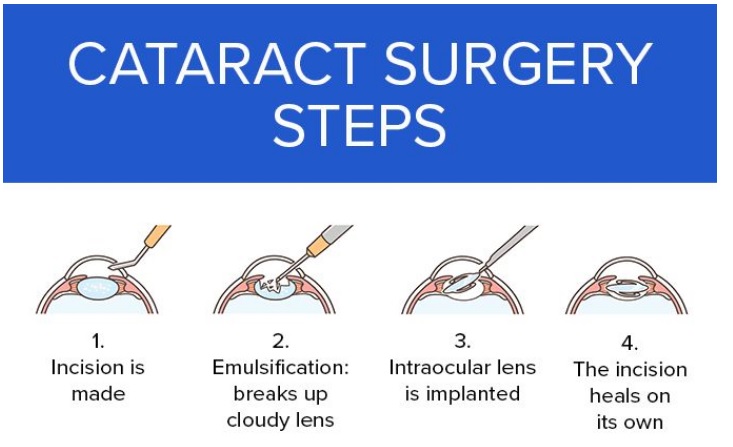What is Cataract Surgery?
Cataract surgery is a popular treatment that includes removing the lens of your eye and replacing it with an artificial intraocular lens (IOL), which performs the same roles that your natural lens does. Cataract surgery can be performed on both eyes at the same time.
Types of intraocular lens
- Monofocal intraocular lenses (IOLs):
These lenses offer excellent distance vision. The majority of people opt to set them for distance vision and then wear reading glasses if they need to see something real close.
- Multifocal intraocular lenses (IOLs) & Accommodative intraocular lenses (IOLs):
These can be used for both close and far focus.
- Toric IOLs:
Because of their ability to correct high cylindrical powers, these unique lenses reduce the patient’s need for distance glasses. Or we can say, “these IOLs are made to help people with astigmatism fix their refractive error.”
Who requires cataract surgery, exactly?
Cataract surgery is an optional procedure rather than an emergency operation that must be performed immediately. But it requires
- When a patient’s vision begins to become blurry.
- When a patient is unable to carry out daily routine activities/professional activities effectively because of foggy vision.
- When there is no improvement in eyesight with a change of spectacles.
- When there is a significant change in color perception.
- When a patient is unable to recognize familiar faces until someone is very close to them, it is the right time to diagnose macular degeneration.
Even if you have these symptoms, you can wait for cataract surgery and have it done when your cataract surgeon thinks it’s best. Surgery is not the first thing you should consider doing if you begin experiencing symptoms. Eyeglasses prescribed by a doctor are a feasible treatment option for early symptoms. It’s time to go on to the next level when your vision becomes so blurry that it interferes with your ability to perform daily tasks. Surgery is the only option for treating cataracts in a way that will be effective in the long term.
Cataract surgery Procedure
Cataract surgery is an outpatient treatment, so you can go home right away.
Prior to the procedure, you might need to fast for a few hours. Your doctor may also ask you to stop using some medications. And it is safe to drive after 24 hours.
Procedure Details
- Either eyedrops or an injection around the eye will be used to numb your eye before the procedure.
- A medication that will help you relax may also be prescribed for you.
- During the surgical procedure, you will be awake.
- During the process, it is possible that you will see light and movement, but you will not be able to see what the doctor is doing to your eye.
- Your doctor examines the area using a specialized microscope. She will make very little incisions close to the rim of your cornea. The surgeon will make these incisions in order to access the lens that is located in your eye. They will use extremely little equipment to break apart the lens that has the cataract in it, and then they will remove it. After that, they will install your brand-new lens.
- The surgical removal of a cataract only takes a few minutes to perform. The complete process often does not take more than twenty to thirty minutes.
- For about four weeks after surgery, you will need to use specific eyedrops.
- It may take several days or weeks for your vision to fully recover.
- So, the only option to remove a cataract and regain clear vision is to undergo surgery known as cataract surgery. There is no other medication or eyedrop that has been demonstrated to improve cataracts.
What is the Cost of Cataract surgery?
If you are qualified for Medicare, the medical expenses associated with cataract surgery will typically be covered by Medicare. Usually, cataract surgery is also covered by private insurance. It will cost you more to have cataract surgery if you decide to get it done before your vision has been severely damaged.
Success Rate of Cataract Surgery: –
cataract surgery is widely regarded as a technique that is very safe and successful. According to the most recent research, it achieves a success rate of between 97 and 98 percent.











